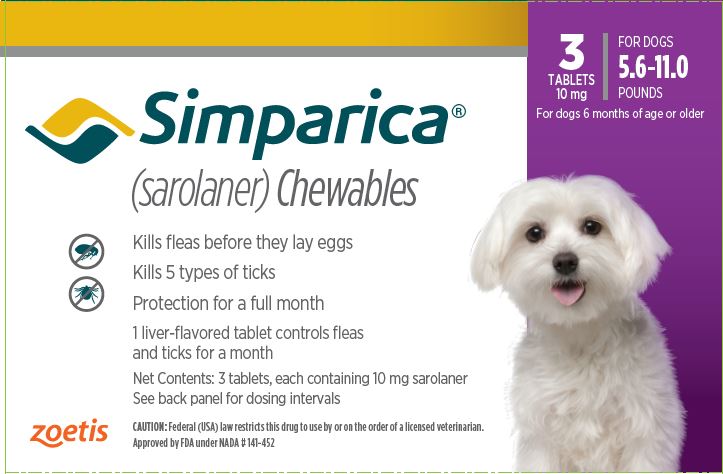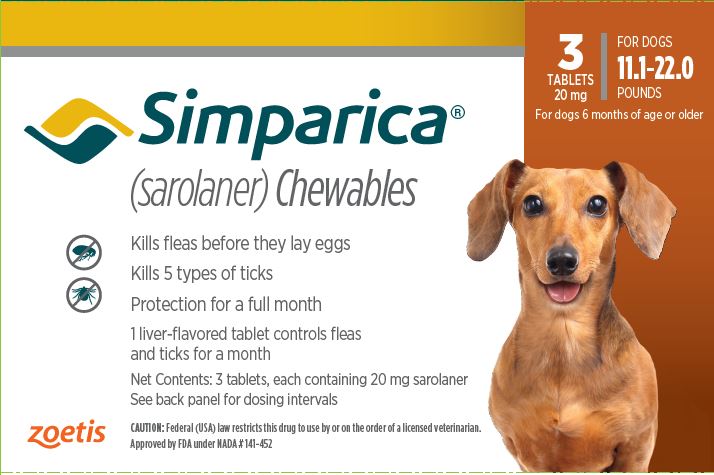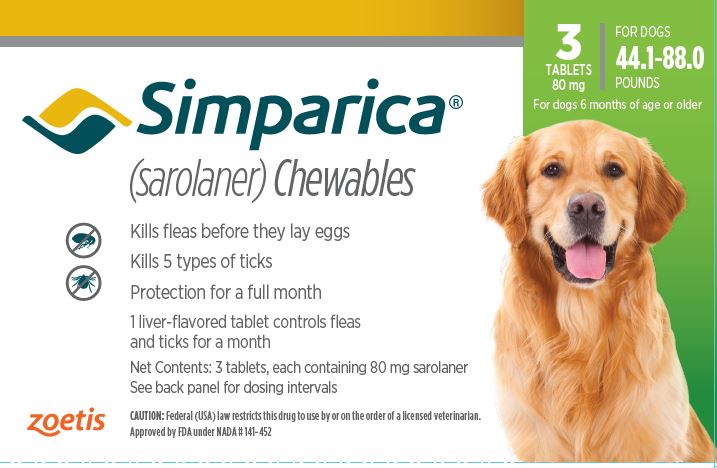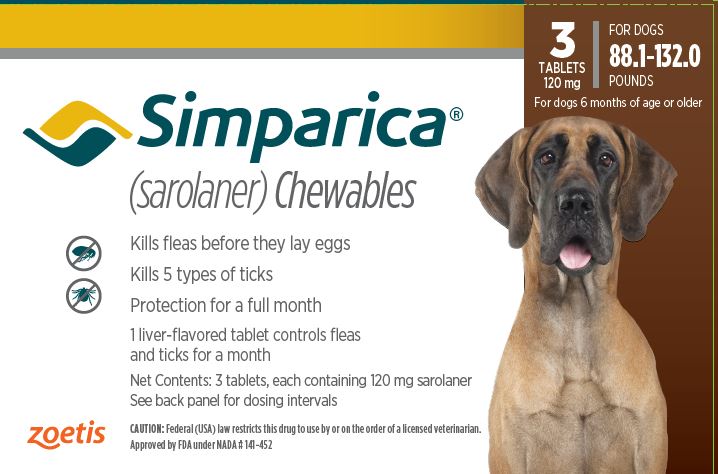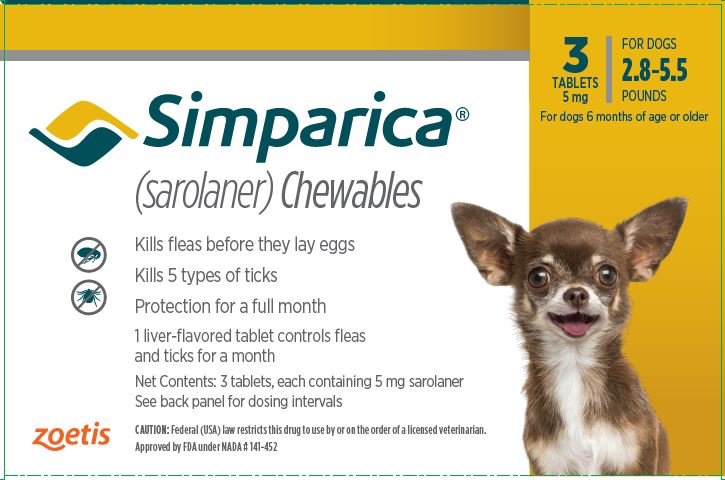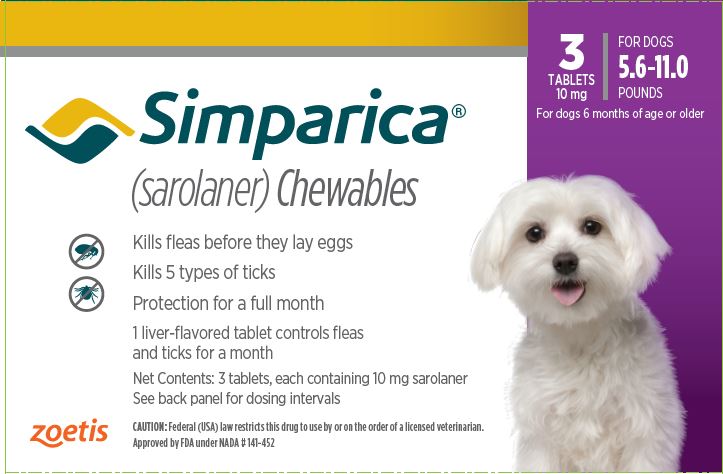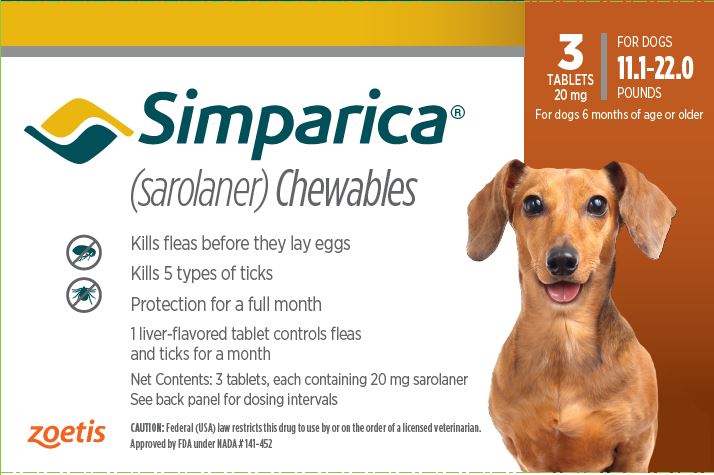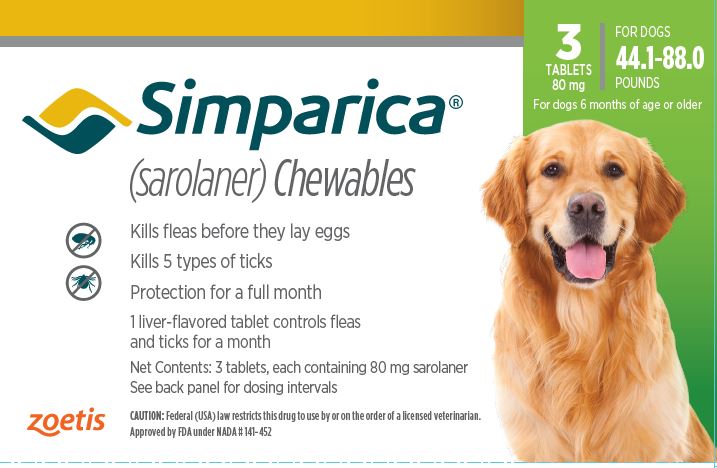Label: SIMPARICA CHEWABLES- sarolaner tablet, chewable
-
NDC Code(s):
54771-2015-1,
54771-2015-2,
54771-2015-3,
54771-2016-1, view more54771-2016-2, 54771-2016-3, 54771-2017-1, 54771-2017-2, 54771-2017-3, 54771-2018-1, 54771-2018-2, 54771-2018-3, 54771-2019-1, 54771-2019-2, 54771-2019-3, 54771-2020-1, 54771-2020-2, 54771-2020-3
- Packager: Zoetis Inc.
- Category: PRESCRIPTION ANIMAL DRUG LABEL
- DEA Schedule: None
- Marketing Status: New Animal Drug Application
Drug Label Information
Updated December 8, 2022
If you are a consumer or patient please visit this version.
- Download DRUG LABEL INFO: PDF XML
- Official Label (Printer Friendly)
- SPL UNCLASSIFIED SECTION
- CAUTION
-
Description
SIMPARICA is a flavored, chewable tablet for administration to dogs over 6 months of age according to their weight. Each tablet is formulated to provide a minimum sarolaner dosage of 0.91 mg/lb (2 mg/kg ) body weight.
Sarolaner is a member of the isoxazoline class of parasiticides and the chemical name is 1-(5'-((5S)-5-(3,5-Dichloro-4-fluorophenyl)-5-(trifluoromethyl)-4,5-dihydroisoxazol-3-yl)-3'-H-spiro(azetidine-3,1'-(2)benzofuran)-1-yl)-2-(methylsulfonyl)ethanone. SIMPARICA contains the S-enantiomer of sarolaner.
-
Indications
SIMPARICA kills adult fleas, and is indicated for the treatment and prevention of flea infestations (Ctenocephalides felis), and the treatment and control of tick infestations [Amblyomma americanum (lone star tick), Amblyomma maculatum (Gulf Coast tick), Dermacentor variabilis (American dog tick), Ixodes scapularis (black-legged tick), and Rhipicephalus sanguineus (brown dog tick)] for one month in dogs 6 months of age or older and weighing 2.8 pounds or greater. SIMPARICA is indicated for the prevention of Borrelia burgdorferi infections as a direct result of killing lxodes scapularis vector ticks.
-
Dosage and Administration
SIMPARICA is given orally once a month at the recommended minimum dosage of 0.91 mg/lb (2 mg/kg).
Dosage Schedule:
Body Weight
SAROLANER per Tablet (mg)
Number of Tablets Administered
2.8 to 5.5 lbs
5
One
5.6 to 11.0 lbs
10
One
11.1 to 22.0 lbs
20
One
22.1 to 44.0 lbs
40
One
44.1 to 88.0 lbs
80
One
88.1 to 132.0 lbs
120
One
>132.1 lbs
Administer the appropriate combination of tablets
SIMPARICA can be offered by hand, in the food, or administered like other tablet medications.
Care should be taken that the dog consumes the complete dose, and treated animals should be observed for a few minutes to ensure that part of the dose is not lost or refused. If a dose is missed, administer SIMPARICA and resume a monthly dosing schedule.
SIMPARICA should be administered at monthly intervals.
Flea Treatment and Prevention:
Treatment with SIMPARICA may begin at any time of the year. In areas where fleas are common year-round, monthly treatment with SIMPARICA can continue the entire year without interruption.
To minimize the likelihood of flea re-infestation, it is important to treat all dogs and cats within a household with an approved flea control product.
Tick Treatment and Control:
Treatment with SIMPARICA can begin at any time of the year (see Effectiveness).
- Contraindications
-
Warnings
Not for use in humans. Keep this and all drugs out of reach of children. For use in dogs only. Do not use SIMPARICA in cats.
SIMPARICA should not be used in dogs less than 6 months of age (see Animal Safety).
Keep SIMPARICA in a secure location out of reach of dogs, cats and other animals to prevent accidental ingestion or overdose. -
Precautions
Sarolaner is a member of the isoxazoline class. This class has been associated with neurologic adverse reactions including tremors, ataxia, and seizures. Seizures have been reported in dogs receiving isoxazoline class drugs, even in dogs without a history of seizures. Use with caution in dogs with a history of seizures or neurologic disorders.
The safe use of SIMPARICA has not been evaluated in breeding, pregnant, or lactating dogs. -
Adverse Reactions
SIMPARICA was administered in a well-controlled US field study, which included a total of 479 dogs (315 dogs treated with SIMPARICA and 164 dogs treated with active control once monthly for three treatments).
Over the 90-day study period, all observations of potential adverse reactions were recorded.Table 1. Dogs with adverse reactions Adverse reaction
sarolaner
sarolaner
active control
active control
N
%
(n = 315)N
#
(n =164)Vomiting
3
0.95%
9
5.50%
Diarrhea
2
0.63%
2
1.20%
Lethargy
1
0.32%
2
1.20%
Inappetence
0
0%
3
1.80%
Additionally, one female dog aged 8.6 years exhibited lethargy, ataxia while posturing to eliminate, elevated third eyelids, and inappetence one day after receiving SIMPARICA concurrently with a heartworm preventative (ivermectin/pyrantel pamoate). The signs resolved one day later. After the day 14 visit, the owner elected to withdraw the dog from the study.
Abnormal neurologic signs such as tremors, decreased conscious proprioception, ataxia, decreased or absent menace, and/or seizures were reported in dogs receiving SIMPARICA (see Animal Safety).
Post Approval Experience (2019):
The following adverse events are based on post-approval adverse drug experience reporting for SIMPARICA. Not all adverse events are reported to FDA CVM. It is not always possible to reliably estimate the adverse event frequency or establish a causal relationship to product exposure using these data.
The following adverse events reported for dogs are listed in decreasing order of reporting frequency:
Vomiting, tremors, lethargy, seizure, diarrhea (with and without blood), anorexia, ataxia, pruritus, hypersalivation and hyperactivity.
For a copy of the Safety Data Sheet (SDS) or to report adverse reactions call Zoetis Inc. at 1-888-963-8471. Additional information can be found at www.SIMPARICA.com. For additional information about adverse drug experience reporting for animal drugs, contact FDA at 1-888-FDA-VETS or www.fda.gov/reportanimalae. -
Clinical Pharmacology
Sarolaner is rapidly and well absorbed following oral administration of SIMPARICA. In a study of 12 Beagle dogs the mean maximum plasma concentration (Cmax) was 1100 ng/mL and the mean time to maximum concentration (Tmax) occurred at 3 hours following a single oral dose of 2 mg/kg to fasted animals. The mean oral bioavailability was 86% and 107% in fasted and fed dogs, respectively. The mean oral T1/2 values for fasted and fed animals was 10 and 12 days respectively.
Sarolaner is distributed widely; the mean volume of distribution (Vdss) was 2.81 L/kg bodyweight following a 2 mg/kg intravenous dose of sarolaner. Sarolaner is highly bound (≥99.9%) to plasma proteins. The metabolism of sarolaner appears to be minimal in the dog. The primary route of sarolaner elimination from dogs is biliary excretion with elimination via the feces.
Following repeat administration of SIMPARICA once every 28 days for 10 doses to Beagle dogs at 1X, 3X, and 5X the maximum intended clinical dose of 4 mg/kg, steady-state plasma concentrations were reached after the 6th dose. Following treatment at 1X, 3X, and 5X the maximum intended clinical dose of 4 mg/kg, sarolaner systemic exposure was dose proportional over the range 1X to 5X.
-
Mode of Action
The active substance of SIMPARICA, sarolaner, is an acaricide and insecticide belonging to the isoxazoline group. Sarolaner inhibits the function of the neurotransmitter gammaaminobutyric acid (GABA) receptor and glutamate receptor, and works at the neuromuscular junction in insects. This results in uncontrolled neuromuscular activity leading to death in insects or acarines.
.
-
Effectiveness
In a well-controlled laboratory study, SIMPARICA began to kill fleas 3 hours after initial administration and reduced the number of live fleas by ≥96.2% within 8 hours after flea infestation through Day 35.
In a separate well-controlled laboratory study, SIMPARICA demonstrated 100% effectiveness against adult fleas within 24 hours following treatment and maintained 100% effectiveness against weekly re-infestations for 35 days.
In a study to explore flea egg production and viability, SIMPARICA killed fleas before they could lay eggs for 35 days. In a study to simulate a flea-infested home environment, with flea infestations established prior to the start of treatment and re-infestations on Days 7, 37 and 67, SIMPARICA administered monthly for three months demonstrated >95.6% reduction in adult fleas within 14 days after treatment and reached 100% on Day 60.
In well-controlled laboratory studies, SIMPARICA demonstrated ≥99% effectiveness against an initial infestation of Amblyomma americanum, Amblyomma maculatum, Dermacentor variabilis, Ixodes scapularis, and Rhipicephalus sanguineus 48 hours post-administration and maintained >96% effectiveness 48 hours post re-infestation for 30 days. In two separate, well-controlled laboratory studies, SIMPARICA was effective at preventing Borrelia burgdorferi infections after dogs were infested with lxodes scapularis vector ticks 28 days post-treatment.
In a well-controlled 90-day US field study conducted in households with existing flea infestations of varying severity, the effectiveness of SIMPARICA against fleas on Day 30, 60 and 90 visits compared to baseline was 99.4%, 99.8%, and 100%, respectively. Dogs with signs of flea allergy dermatitis showed improvement in erythema, papules, scaling, alopecia, dermatitis/pyodermatitis and pruritus as a direct result of eliminating fleas.
-
Animal Safety
In a margin of safety study, SIMPARICA was administered orally to 8-week-old Beagle puppies at doses of 0, 1X, 3X, and 5X the maximum recommended dose (4 mg/kg) at 28-day intervals for 10 doses (8 dogs per group). The control group received placebo tablets. No neurologic signs were observed in the 1X group. In the3X group, one male dog exhibited tremors and ataxia post-dose on Day 0; one female dog exhibited tremors on Days 1, 2, 3, and 5; and one female dog exhibited tremors on Day 1. In the 5X group, one female dog had a seizure on Day 61 (5 days after third dose); one female dog had tremors post-dose on Day 0 and abnormal head coordination after dosing on Day 140; and one female dog exhibited seizures associated with the second and fourth doses and tremors associated with the second and third doses. All dogs recovered without treatment. Except for the observation of abnormal head coordination in one dog in the 5X group two hours after dosing on Day 140 (dose 6). There were no treatment-related neurological signs observed once the dogs reached the age of 6 months.
In a separate exploratory pharmacokinetic study, one female dog dosed at 12 mg/kg (3X the maximum recommended dose) exhibited lethargy, anorexia, and multiple neurological signs including ataxia, tremors, disorientation, hypersalivation, diminished proprioception, and absent menace, approximately 2 days after a third monthly dose. The dog was not treated, and was ultimately euthanized. The first two doses resulted in plasma concentrations that were consistent with those of the other dogs in the treatment group. Starting at 7 hours after the third dose, there was a rapid 2.5 fold increase in plasma concentrations within 41 hours, resulting in a Cmax more than 7-fold higher than the mean Cmax at the maximum recommended use dose. No cause for the sudden increase in sarolaner plasma concentrations was identified.
- Storage Information
- How Supplied
- SPL UNCLASSIFIED SECTION
- PRINCIPAL DISPLAY PANEL 5 mg Carton
- PRINCIPAL DISPLAY PANEL 10 mg Carton
- PRINICIPAL DISPLAY PANEL 20 mg Carton
- PRINCIPAL DISPLAY PANEL 40 mg Carton
- PRINCIPAL DISPLAY PANEL 80 mg Carton
- PRINCIPAL DISPLAY PANEL 120 mg Carton
-
INGREDIENTS AND APPEARANCE
SIMPARICA CHEWABLES
sarolaner tablet, chewableProduct Information Product Type PRESCRIPTION ANIMAL DRUG Item Code (Source) NDC:54771-2015 Route of Administration ORAL Active Ingredient/Active Moiety Ingredient Name Basis of Strength Strength SAROLANER (UNII: DM113FTW7F) (SAROLANER - UNII:DM113FTW7F) SAROLANER 5 mg Product Characteristics Color brown Score no score Shape SQUARE (Square with rounded edges) Size 6mm Flavor LIVER Imprint Code Contains Packaging # Item Code Package Description Marketing Start Date Marketing End Date 1 NDC:54771-2015-1 1 in 1 CARTON 1 1 in 1 BLISTER PACK 2 NDC:54771-2015-2 1 in 1 CARTON 2 3 in 1 BLISTER PACK 3 NDC:54771-2015-3 2 in 1 CARTON 3 3 in 1 BLISTER PACK Marketing Information Marketing Category Application Number or Monograph Citation Marketing Start Date Marketing End Date NADA NADA141452 02/24/2016 SIMPARICA CHEWABLES
sarolaner tablet, chewableProduct Information Product Type PRESCRIPTION ANIMAL DRUG Item Code (Source) NDC:54771-2016 Route of Administration ORAL Active Ingredient/Active Moiety Ingredient Name Basis of Strength Strength SAROLANER (UNII: DM113FTW7F) (SAROLANER - UNII:DM113FTW7F) SAROLANER 10 mg Product Characteristics Color brown Score no score Shape SQUARE (Square with rounded edges) Size 8mm Flavor LIVER Imprint Code Contains Packaging # Item Code Package Description Marketing Start Date Marketing End Date 1 NDC:54771-2016-1 1 in 1 CARTON 1 1 in 1 BLISTER PACK 2 NDC:54771-2016-2 1 in 1 CARTON 2 3 in 1 BLISTER PACK 3 NDC:54771-2016-3 2 in 1 CARTON 3 3 in 1 BLISTER PACK Marketing Information Marketing Category Application Number or Monograph Citation Marketing Start Date Marketing End Date NADA NADA141452 02/24/2016 SIMPARICA CHEWABLES
sarolaner tablet, chewableProduct Information Product Type PRESCRIPTION ANIMAL DRUG Item Code (Source) NDC:54771-2017 Route of Administration ORAL Active Ingredient/Active Moiety Ingredient Name Basis of Strength Strength SAROLANER (UNII: DM113FTW7F) (SAROLANER - UNII:DM113FTW7F) SAROLANER 20 mg Product Characteristics Color brown Score no score Shape SQUARE Size 10mm Flavor LIVER Imprint Code Contains Packaging # Item Code Package Description Marketing Start Date Marketing End Date 1 NDC:54771-2017-1 1 in 1 CARTON 1 1 in 1 BLISTER PACK 2 NDC:54771-2017-2 1 in 1 CARTON 2 3 in 1 BLISTER PACK 3 NDC:54771-2017-3 2 in 1 CARTON 3 3 in 1 BLISTER PACK Marketing Information Marketing Category Application Number or Monograph Citation Marketing Start Date Marketing End Date NADA NADA141452 02/24/2016 SIMPARICA CHEWABLES
sarolaner tablet, chewableProduct Information Product Type PRESCRIPTION ANIMAL DRUG Item Code (Source) NDC:54771-2018 Route of Administration ORAL Active Ingredient/Active Moiety Ingredient Name Basis of Strength Strength SAROLANER (UNII: DM113FTW7F) (SAROLANER - UNII:DM113FTW7F) SAROLANER 40 mg Product Characteristics Color brown Score no score Shape SQUARE Size 14mm Flavor LIVER Imprint Code Contains Packaging # Item Code Package Description Marketing Start Date Marketing End Date 1 NDC:54771-2018-1 1 in 1 CARTON 1 1 in 1 BLISTER PACK 2 NDC:54771-2018-2 1 in 1 CARTON 2 3 in 1 BLISTER PACK 3 NDC:54771-2018-3 2 in 1 CARTON 3 3 in 1 BLISTER PACK Marketing Information Marketing Category Application Number or Monograph Citation Marketing Start Date Marketing End Date NADA NADA141452 02/24/2016 SIMPARICA CHEWABLES
sarolaner tablet, chewableProduct Information Product Type PRESCRIPTION ANIMAL DRUG Item Code (Source) NDC:54771-2019 Route of Administration ORAL Active Ingredient/Active Moiety Ingredient Name Basis of Strength Strength SAROLANER (UNII: DM113FTW7F) (SAROLANER - UNII:DM113FTW7F) SAROLANER 80 mg Product Characteristics Color brown Score no score Shape SQUARE Size 16mm Flavor LIVER Imprint Code Contains Packaging # Item Code Package Description Marketing Start Date Marketing End Date 1 NDC:54771-2019-1 1 in 1 CARTON 1 1 in 1 BLISTER PACK 2 NDC:54771-2019-2 1 in 1 CARTON 2 3 in 1 BLISTER PACK 3 NDC:54771-2019-3 2 in 1 CARTON 3 3 in 1 BLISTER PACK Marketing Information Marketing Category Application Number or Monograph Citation Marketing Start Date Marketing End Date NADA NADA141452 02/24/2016 SIMPARICA CHEWABLES
sarolaner tablet, chewableProduct Information Product Type PRESCRIPTION ANIMAL DRUG Item Code (Source) NDC:54771-2020 Route of Administration ORAL Active Ingredient/Active Moiety Ingredient Name Basis of Strength Strength SAROLANER (UNII: DM113FTW7F) (SAROLANER - UNII:DM113FTW7F) SAROLANER 120 mg Product Characteristics Color brown Score no score Shape SQUARE Size 19mm Flavor LIVER Imprint Code Contains Packaging # Item Code Package Description Marketing Start Date Marketing End Date 1 NDC:54771-2020-1 1 in 1 CARTON 1 1 in 1 BLISTER PACK 2 NDC:54771-2020-2 1 in 1 CARTON 2 3 in 1 BLISTER PACK 3 NDC:54771-2020-3 2 in 1 CARTON 3 3 in 1 BLISTER PACK Marketing Information Marketing Category Application Number or Monograph Citation Marketing Start Date Marketing End Date NADA NADA141452 02/24/2016 Labeler - Zoetis Inc. (828851555)


